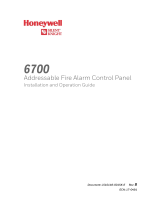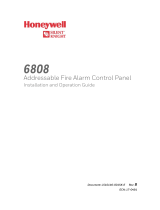
Use 12 to 22 AWG conductors to connect to terminals of bases. It is recommended
that the SLC conductors be color-coded to avoid wiring errors and assist in system
troubleshooting. Improper SLC connections may prevent the system from
operating normally. Disconnect power to the SLC until the detectors are installed.
1. Wire the detector bases according to Field Wiring Diagrams.
2. Use the dip switches (SECTION 11) to set address(es) (1 - 127) for each detector
head.
NOTICE:
THE PAD100IB, PAD100RB AND PAD100SB OBTAINS THE ADDRESS FROM
THE DETECTOR HEAD.
THE DETECTORS AND THE PAD100 MODULES MUST HAVE INDIVIDUAL
ADDRESSES.
3. To install the detector head onto the base, match the detector heads to the
base using the alignment feature and twist clockwise until the detector heads
snap into place (FIGURE 6).
4. After all detector heads, addressable bases and modules have been installed,
apply power to the FACP.
5. Test the detectors as described in the Testing Section of this manual.
NOTICE: DO NOT INSTALL DETECTOR HEADS UNTIL AREA HAS BEEN
THOROUGHLY CLEANED TO REMOVE CONSTRUCTION DEBRIS, DUST, ETC.,
AS REQUIRED BY NFPA 72.
4. Spacing Limitations
NOTICE: REFER TO NFPA 72 FOR SPECIFIC INFORMATION REGARDING DETECTOR
SPACING, MOUNTING LOCATION AND SPECIAL APPLICATIONS.
PAD100-PD, PAD200-PD, PAD100-PHD, PAD200-PCD, PAD200-PCHD and PAD200-
PHD: Photoelectric Smoke Detector
PAD100-PD, PAD200-PD, PAD200-PCD, PAD200-PCHD, PAD100-PHD and PAD200-
PHD are ANSI/UL listed on maximum 30ft spacing limitation with alarm set point
from 135O-174O F on smooth ceiling. Refer to NFPA 72 for specic information
regarding detector spacing, placement and special applications.
PAD100-HD: Heat Detector
The ANSI/UL listed spacing limitations of PAD100-HD smooth ceiling are
dependent on alarm set point.
5. Testing
Testing shall be performed periodically to determine if each detector operates
properly. Detectors will oer maximum performance when tested in compliance
with NFPA 72.
NOTICE: REFER TO FIRE ALARM CONTROL PANEL FACP MANUAL FOR
OPERATION OF DIRTY VALUE READ / PRINT, ALARM SIMULATION AND WALK TEST.
Operational Testing
When PAD100-PD, PAD200-PD, PAD100-PHD, PAD200-PHD, PAD200-PCD, PAD200-
PCHD, PAD100-HD and PAD100-CD are under normal conditions in standby mode,
the alarm indicator LEDs will pulse approximately once every 4 seconds.
NOTICE: WHEN A PANEL IS CONFIGURED TO NOT FLASH LEDS, THE LEDS ON THE
DETECTORS WILL NOT FLASH AT ANY TIME.
Sensitivity Testing
(Dirty Value Read / Print)
The sensitivity drift value (Dirty Value) of the smoke detector can be checked at the
FACP. The Dirty Value can be read and printed out at the FACP.
NOTICE: DETECTOR COMPENSATES SENSITIVITY UNTIL LIMIT OF
COMPENSATION. WHEN COMPENSATION RATE REACHES LIMIT, A TROUBLE
SIGNAL WILL BE INDICATED ON THE FACP.
Functional Testing
NOTICE: BE SURE TO DISENGAGE ALL ALARM SIGNAL SERVICES, RELEASING
DEVICES AND EXTINGUISHING SYSTEMS, PRIOR TO PERFORMING THE
FOLLOWING TEST, EXCEPT AUTOMATIC TESTING BY THE FACP. BE SURE TO
REENGAGE THESE SYSTEMS WHEN ALL TESTING IS COMPLETE.
Walk Test
The FACP must be placed into Walk Test Mode and follow the steps below.
Use the appropriate steps outlined below for the detector that is to be tested.
CAUTION! FAILURE TO ALARM DURING A TEST INDICATES A DEFECTIVE
DETECTOR. REPLACE DETECTOR IMMEDIATELY.
a. PAD100-PD, PAD200-PD, PAD200-PCD, PAD200-PCHD, PAD100-PHD and
PAD200-PHD Smoke Detectors:
Use the Home Safeguard Model 25S or SDi Smoke Centurion as acceptable
to the Authority Having Jurisdiction (AHJ).
b. PAD100-PHD, PAD200-PCHD, PAD200-PHD and PAD100-HD Heat Detectors:
NOTICE: TAKE CARE DURING THE HEATING OF THE DETECTOR TO AVOID
OVERHEATING THE PLASTIC HOUSING.
Use of a low powered heat gun is acceptable.
CAUTION! Do not heat over 210oF (98.9oC).
Maintain a minimum of 1 foot between the detector and the heat gun
nozzle.
Heat the detector for a minimum of 10 seconds.
FACP will indicate with alarm when a sucient amount of heat has been
applied. LED indicator will continuously ash while detector is in alarm.
c. PAD100-CD, PAD200-PCD, PAD200-PCHD,: Carbon Monoxide Detector: Use
the Home Safeguard Model HO-CO2 Aerosol with Home Safeguard Model
Versa-Test Head VT1 or the SDI Solo C6 Aerosol with SDI Solo 330 Dispenser as
acceptable to the Authority Having Jurisdiction (AHJ).
NOTICE: NEVER USE EXHAUST FROM VEHICLE TO TEST CO PORTION OF
DETECTOR. EXHAUST MAY CAUSE PERMANENT DAMAGE TO DETECTOR AND
VOIDS THE WARRANTY.
6. Maintenance
The detector should be cleaned as needed. Detectors installed in environments
more prone to dust may need cleaning based on build-up of dust. The Dirty Value
Report provides an indication when the detectors should be cleaned.
NOTICE:
THE DETECTOR IS NOT WASHABLE, DO NOT SUBMERGE THE DETECTOR IN
WATER. WATER CAN AFFECT THE SENSOR, CAUSING PERMANENT DAMAGE.
DO NOT SPRAY CLEANING CHEMICALS OR INSECT SPRAYS DIRECTLY ON
OR NEAR THE DETECTOR. DO NOT PAINT OVER THE DETECTOR. DOING
SO MAY CAUSE PERMANENT DAMAGE.
a. PAD100-PHD, PAD200-PHD, PAD200-PCD, PAD200-PCHD, PAD100-HD and
PAD100-CD: When cleaning is needed, clean cover using a soft cloth.
DO NOT vacuum or use compressed air, water, cleaners or solvents to clean
the detector.
DO NOT disassemble the detector to clean.
If the detector is not operating properly after cleaning, replace detector.
b. PAD100-PD and PAD200-PD: When cleaning is needed, follow the below steps
to remove dust on the detector:
1. Turn o electrical power to the PAD100-PD and PAD200-PD.
2. Remove the detector from the base. Do not remove the base from the wall.
3. Remove cover from detector by removing the two screws (T10) on back of
detector (FIGURE 7).
DO NOT USE A POWER DRIVER WHEN REMOVING /INSTALLING SCREWS.
Alarm Set-Point Rate of Rise Spacing Fixed Temperature Spacing
135O to 174O F
(57O to 79O C) Maximum 60 ft. Maximum 60 ft.
175O to 185O F
(80O to 85O C) Maximum 15 ft. Maximum 15 ft.
135O to 160O F
(57O to 71O C) Maximum 70 ft. Maximum 70 ft.
FIGURE 6: Assembly of Detector
Alignment
Features
Mount the detector bracket
to the back box using the
mounting screws.
Using the two
included screws,
attached the
detector base to
detector bracket.









